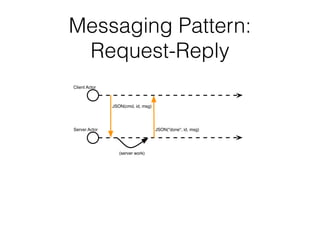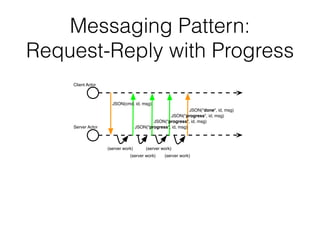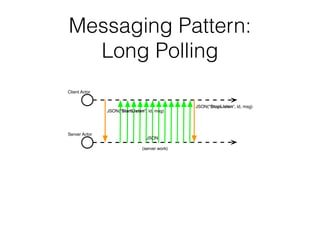Messaging patterns
- 1. Messaging Patterns with Akka (Remote) Actors John Nestor and Dragos Manolescu Whitepages, Inc. April 14, 2015
- 2. Prelude âĒ JLine (http://jline.sourceforge.net) âĒ Command history, tab completion, line editing âĒ Custom key bindings âĒ PersistJson (https://github.com/nestorpersist/json) âĒ Fast Scala JSON parser âĒ JSON tree/Scala classes âĒ Pretty/Compact âĒ Demo code at https://github.com/polymorphic/akka-messaging- patterns.git
- 3. Akka Remote Actors âĒ Design decisions: âĒ Symmetric communication âĒ Symmetric roles âĒ Remote scenarios: âĒ Lookup âĒ Remote creation
- 4. Akka Actor Model Actor BehaviorMailbox Parent Child Child M M M Actor BehaviorMailbox Messages - ConïŽguration - Thread pools Actor System
- 5. Akka Actor Model w/ Remoting Actor BehaviorMailbox Parent Child Child M M MActor BehaviorMailbox Messages - ConïŽguration - Thread pools Actor System Lookup via ActorSelection Remote creation via deployment conïŽguration - ConïŽguration - Thread pools Actor System
- 6. Actor System ConïŽguration for Remoting akka { actor { provider = "akka.remote.RemoteActorRefProvider" } remote { enabled-transports = ["akka.remote.netty.tcp"] netty.tcp { hostname = "127.0.0.1" port = 2552 } } }
- 7. Messaging Pattern: OneWay Client Actor Server Actor JSON(cmd, id, msg) (server work)
- 8. Messaging Pattern: Request-Reply Client Actor Server Actor JSON(cmd, id, msg) (server work) JSON("done", id, msg)
- 9. Messaging Pattern: Request-Reply with Failure Client Actor Server Actor JSON(cmd, id, msg) (server work) JSON("fail", id, msg)
- 10. Messaging Pattern: Request-Reply with Ack Client Actor Server Actor (server work) JSON("done", id, msg) JSON(cmd, id, msg) JSON("ack", id, msg) Timer
- 11. Messaging Pattern: Request-Reply with Progress Client Actor Server Actor (server work) JSON("done", id, msg) JSON(cmd, id, msg) (server work) (server work) (server work) JSON("progress", id, msg) JSON("progress", id, msg) JSON("progress", id, msg)
- 12. Messaging Pattern: Request-Reply with Query Client Actor Server Actor (server work) JSON(cmd, id, msg) (user input) (server work) JSON("query", id, msg) JSON (server work) JSON("done", id, msg) Repeat 2x
- 13. Messaging Pattern: Long Polling Client Actor Server Actor (server work) JSON("StopListen", id, msg) JSON JSON("StartListen", id, msg)
- 14. Messaging Patterns âĒ More patterns: âĒ Sender retries on timeout or failure âĒ A -> B, B -> C, C responds to A directly âĒ Routers âĒ Suggestions for more patterns welcome!
- 15. Summary: Remote Actors or HTTP? âĒ Remote actors: âĒ Symmetric; uniform for local/remote âĒ Rich interaction patterns, very simple protocol âĒ Problems with NAT and load balancers âĒ HTTP: âĒ Asymmetric; remote-only âĒ Simple interaction patterns, complex protocol âĒ Ubiquitous âĒ Originally designed for a very different purpose
- 16. For More Information âĒ Sample code: https://github.com/polymorphic/akka- messaging-patterns.git âĒ Akka remoting: http://doc.akka.io/docs/akka/2.3.9/ scala/remoting.html âĒ JLine http://jline.sourceforge.net âĒ PersistJson https://github.com/nestorpersist/json âĒ Effective Akka, Patterns and Best Practices by Jamie Allen
- 17. Thank you




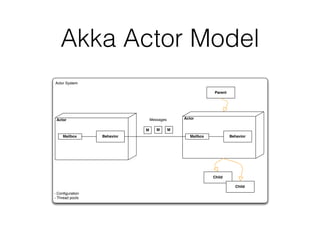
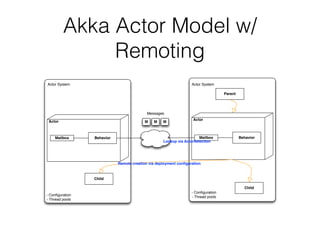
![Actor System ConïŽguration
for Remoting
akka {
actor {
provider = "akka.remote.RemoteActorRefProvider"
}
remote {
enabled-transports = ["akka.remote.netty.tcp"]
netty.tcp {
hostname = "127.0.0.1"
port = 2552
}
}
}](https://image.slidesharecdn.com/messagingpatterns-160223193449/85/Messaging-patterns-6-320.jpg)

